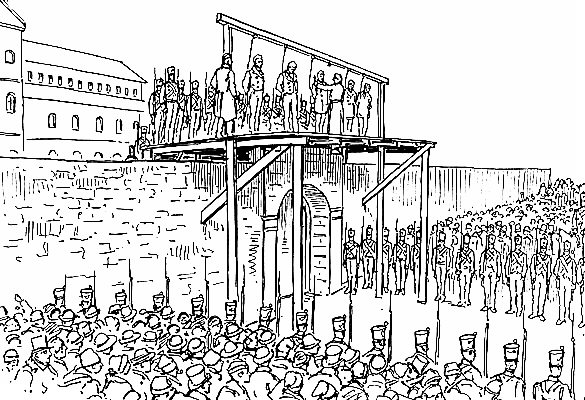| The Patriot Insurrection 1837-1838 |
Written and contributed by Joseph Hamelin
After 74 years of British rule, the French-Canadians revolted in 1837-38, a series of skirmishes vaguely remembered as the Papineau rebellion. The British troops crushed it. Few Americans know of it because, unlike the American and French revolutions that inspired it, it didn't succeed. Canada is still run by the British -- and the winners get to write all the history books. Canada's Nathan Hales are barely remembered, if at all.
One of those "patriots," who ended up hung, was a Hamelin.
Our branch of the Hamelin family by then had settled around LaPrairie, a rebel stronghold south across the St. Lawrence from Montreal. The Hamelin, Robert (ro-bear') and Vachereau families all were involved in the brief but bloody rebellion.
On Nov. 22, 1837, a poorly armed Patriot army of 700 routed a British contingent at St.-Denis. But two days later the British reversed the outcome at St.-Charles, burned villages afterward, and three weeks later smashed the rebels again at St.-Eustache.
Continuing foment led to the suspension of the constitution in February. In response on Feb. 28, rebel leader Robert Nelson -- hiding out in New York and Vermont, where he was raising an army for an invasion -- issued a declaration of independence for the Republic of Low-Canada, of which he declared himself president.
It was a remarkable document, calling for freely elected assemblies, equality for the "savages," separation of church and state, an end to prison for common debt, abolition of the seigneuries, freedom of the press, nationalization of Crown land and a bilingual system.
Francois-Xavier Hamelin dit Petit apparently thought it worth fighting fpr.
When Nelson's 1,000 men (with only 250 rifles) crossed into Canada on November 8, a British army of 8,000 routed them at Napierville, not far from Rouses Point in extreme Northern New York, where Rodney would grow up 60 years later. Nelson slipped back into New York, where he lived out his years.
Francois -- grandson of Rene, my g-g-g-g-grandfather -- wasn't so lucky.
The British promptly arrested 800, most from the Montreal area, and courts-martialed 108 -- condemning 99, among them Francois-Xavier Hamelin, a young farmer from St.-Philippe.
According to a 1953 article in the "Revue d'Histoire de l`Amerique Francaise," Francois-Xavier was part of a troop of 150 men led by 58-year-old militia capitaine Joseph Robert, under the overall command of 21-year-old merchant Hubert Lefebvre-Rigoche, the young insurrection leader in the area south of La Prairie. On Nov. 3, 1838, the armed band was marching from La Tortue to burn the barracks at La Prairie and to seize the Princess Victoria, the boat used by the Loyalists to cross the St. Lawrence between La Prairie and Montreal. The band went door to door that day, and the inhabitants either joined up or went as their prisoners. There was the expectation of joining forces with other groups that day. They never materialized.
Nearing La Prairie, they came upon a group of Loyalists repairing a road and disarmed them with little difficulty. More, however, were barricaded in the home of a man named David Vitty. The rebels demanded they come out, and when they did not, and a shot supposedly came from inside the house, the rebels broke in, guns blazing.
Vitty was badly wounded and a British officer, Aaron Walker, was killed.
Four who entered the house -- Robert, Ambroise and Charles Sanguinet, and Hamelin, all from the St.-Philippe area, like Lefebvre-Rigoche - were executed. Lefebvre was not, because a week after the incident the rebel "general" - Francois-Xavier's first cousin - fled to the U.S., where he lived out his days in exile, dying in Minnesota in 1899.
Francois-Xavier was the son of Rene Jr. (bother of our ancestor Joseph) and Marie-Louise Vachereau (sister to both Hubert's mother, Catherine, and to Joseph's second wife, Suzanne) . F-X was the youngest (at either 18, 21 or 23) of the 12 hung. Fifty-eight were deported to Australia (some punishment!!). The rest were paroled.
It accomplished what the British intended. It discouraged any further shenanigans.
About this time, and it was hardly coincidence, my great-great-grandfather Alexis, and his 17-year-old son Joseph, crossed into New York.

It ended, for our line of Hamelins, two centuries of limited horizons in a small, harsh environment, marrying one generation after another of Trottiers and raising huge families -- often 12 or more children, handy for working the farms.
Those cornerstone Hamelins, among them Louis (12 children), Francois (15), and Francois' son Laurent (12), tended to live surprisingly long lives. Francois made 66, Louis 68, Laurent 65.
Later, in somewhat easier times and more hospitable places, Alexis Hamelin (1788-1870) would live to 82, son Joseph Hamelin (1822-1908) reached 85, son Gilbert (1856-1946) made 90, and his son Rodney (1890-1985) lived to be 95.
They were the gene-hardened heirs of the Hamelins who pioneered Canada.
Also by Joseph Hamelin